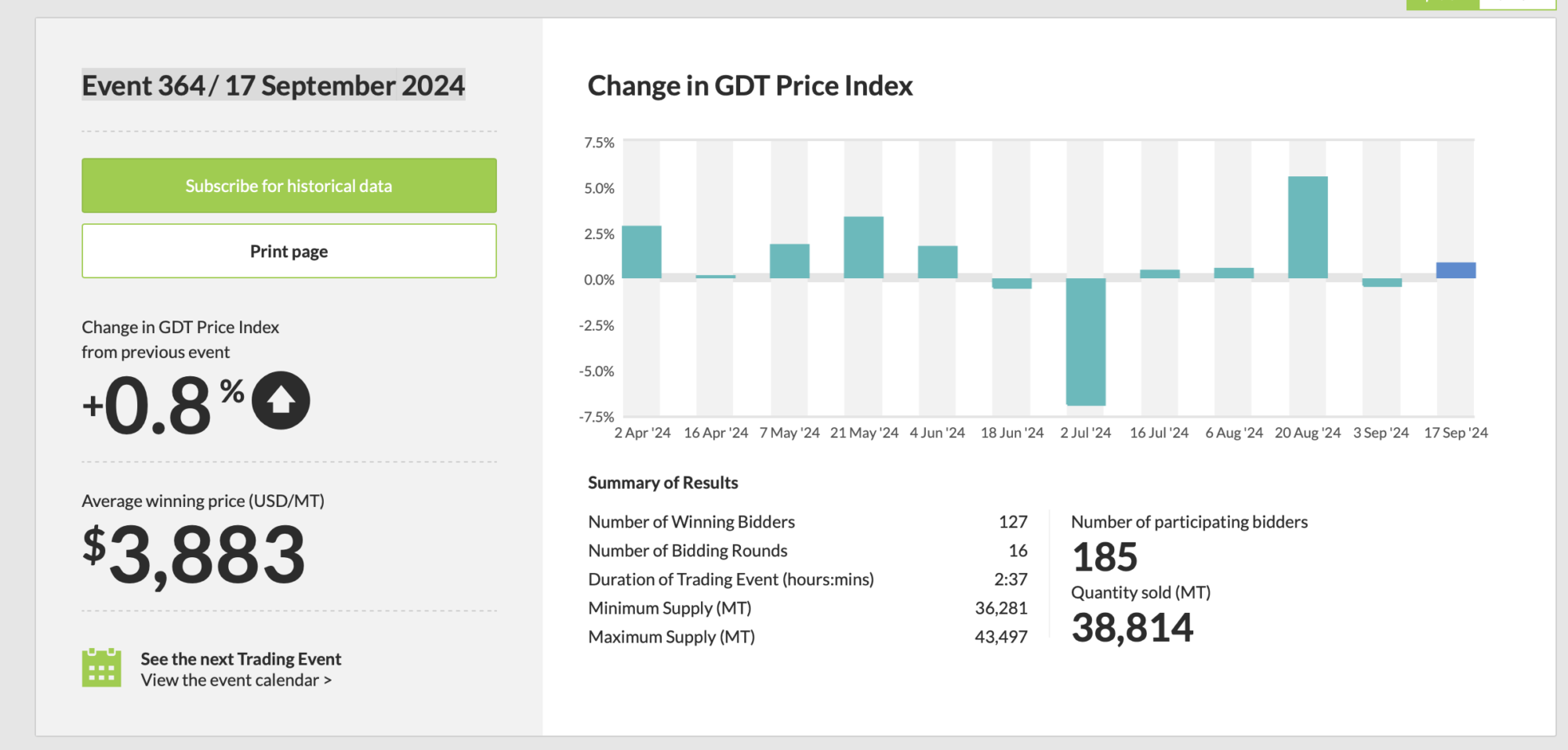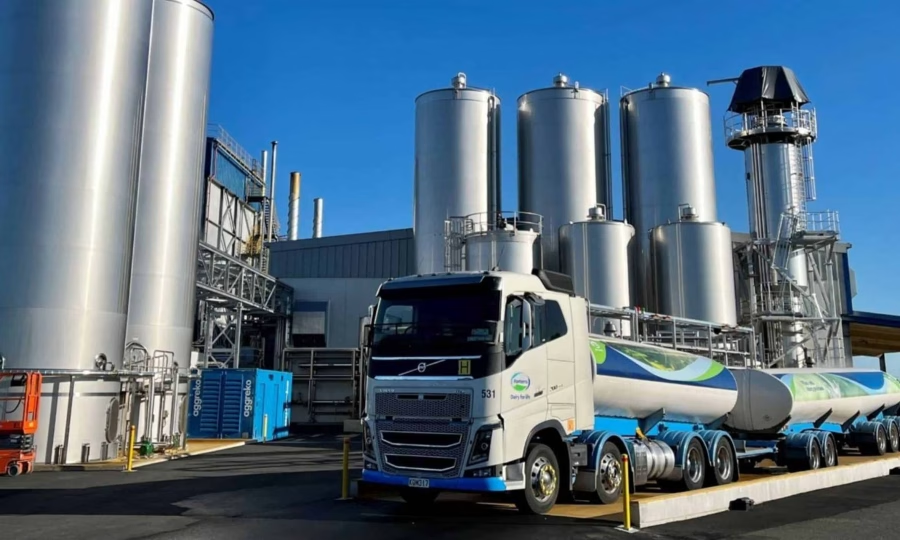Discover the changing trends in the global dairy market. How can farmers handle price changes, production shifts, and new opportunities to boost their profits?
Summary:
The Global Dairy Market Reports for the week ending January 20, 2025, reveal a mixed situation for dairy farmers worldwide. Market prices are going up and down, with European butter and skim milk powder (SMP) prices falling, but Singapore Exchange (SGX) futures are showing a rise in whole milk powder (WMP) and SMP prices. U.S. milk production forecasts have been lowered, which might help increase dairy prices. Europe sees drops in milk production in Germany but increases in France and Italy. Challenges include rising feed costs and disease outbreaks in Europe, while opportunities arise from tight milk supply and new developments in the industry. Farmers should monitor trends, manage costs, and seize opportunities to stay ahead in this changing market.
Key Takeaways:
- The dairy market outlook is mixed, with downward and upward trends affecting various regional segments.
- European futures show declines in butter and SMP prices, while SGX futures indicate positive trends, particularly in WMP and SMP prices.
- Milk production variability in Europe, with declines in Germany and increases in countries such as France and Italy, impacts global supply and pricing.
- The USDA’s lowered forecasts for US milk production could bolster prices, offering some relief to farmers amidst other challenges.
- Disease outbreaks in Europe, notably Germany, could disrupt local markets and create export opportunities for unaffected regions.
- Rising feed costs remain a significant concern that could pressure profit margins if milk prices do not keep pace with expense increases.
- Opportunities arise as tight milk supply and new cheese plant openings in the US may lead to competitive demand and potentially higher farm-gate prices.
- Farmers are advised to closely monitor market trends, manage feed costs diligently, and seize emerging opportunities to optimize outcomes.

As of January 20, 2025, the global dairy industry is in flux, presenting farmers with challenges and opportunities. Market prices and milk production in Europe and the US are changing due to disease threats, rising feed costs, and evolving market demands. European butter and Skim Milk Powder (SMP) prices are decreasing, and US milk production forecasts for 2024 are subdued. Farmers should actively monitor market trends, manage feed costs efficiently, and capitalize on supply changes and disease impacts.
| Market Segment | EEX Prices (Jan-Aug 2025) | SGX Prices (Jan-Aug 2025) |
|---|---|---|
| Butter | €7,208 (down 0.6%) | $6,448 (up 0.3%) |
| SMP | €2,644 (down 0.7%) | $2,930 (up 3.6%) |
| Whey | €965 (down 2.6%) | Not Available |
| WMP | Stable | $3,883 (up 4.0%) |
Uneven Terrain: Navigating Mixed Market Price Trends in the Dairy Industry
The global dairy market shows positive and negative price trends that could affect farmers’ earnings. Butter and Skim Milk Powder (SMP) prices are decreasing in Europe. Butter futures are down 0.6% to €7,208, and SMP futures are down 0.7% to €2,644. These decreases could concern farmers who depend on these products for income, as reduced prices may lead to profit reductions.
In contrast, the futures market operated by SGX presents a more optimistic outlook, particularly for Whole Milk Powder (WMP) and SMP. WMP prices rose 4.0% to $3,883, and SMP went up 3.6% to $2,930. These increases may help balance out the weaker European market. Farmers need to watch these changes closely. They might need to adjust their production plans or find better markets to take advantage of higher prices while dealing with lower prices in other areas.
| Region/Product | Butter | SMP | WMP | Whey |
|---|---|---|---|---|
| European EEX Futures | -0.6% (€7,208) | -0.7% (€2,644) | N/A | -2.6% (€965) |
| SGX Futures | +0.3% ($6,448) | +3.6% ($2,930) | +4.0% ($3,883) | N/A |
| EU Quotations | +0.8% (€7,413) | -1.7% (€2,522) | 0% (€4,446) | -0.8% (€873) |
The Shifting Landscape
Milk production in Europe is showing different trends in various countries. Germany experienced a decrease in milk production, with November’s output declining by 1.9% compared to the previous year. This decrease might make the milk supply tighter across Europe. Meanwhile, France, Italy, and Denmark have increased production. In November, France was up by 1.8%, Italy by 1.9%, and Denmark by 0.7% year-over-year.
These differences could affect global milk supply and prices. Decreasing Germany’s production could lead to higher prices if demand remains high. However, more milk from France, Italy, and Denmark might balance things out, preventing a significant price jump. This could also trigger increased competition among countries as they seek to sell more milk globally. However, this competition could also lead to better prices for farmers, offering a glimmer of hope amid market changes and a potential for increased profits.
Strategic planning is crucial for dairy farmers in the current market landscape. If Germany’s milk production remains low, farmers can benefit from higher prices or adjust their costs if there’s an excess of milk elsewhere. These changes underscore the importance of strategic planning in navigating the milk market, with price fluctuations and European production shifts influencing global milk sales. By carefully monitoring these changes, farmers can make informed decisions to safeguard their businesses, empowering them to take control of their operations.
Forecasting the Future: USDA’s Revised Milk Production Projections and Their Impact on Dairy Prices
| Statistic | 2024 Forecast | 2025 Forecast |
|---|---|---|
| US Milk Production (million tonnes) | 102.4 | 103.1 |
| % Change from Previous Year | -0.2% | +0.3% |
| US Milk Production per Cow | Slower Growth | |
| Fat Basis Exports | Increase | |
| Milk Supply Tightness Impact | Potential Support for Prices | |
In a significant change that might help US dairy farmers, the USDA lowered its predictions for milk production in 2024 and 2025. The latest report expects US milk production in 2024 to drop by 0.2% from 2023, going from 102.6 million tonnes to 102.4 million tonnes. The 2025 prediction is also down from 103.4 million tonnes to 103.1 million tonnes. This adjustment is attributed to a decrease in the growth rate in milk production per cow.
Reducing milk production could lead to more stable or higher prices for dairy farmers. Typically, a decrease in milk supply, coupled with steady or increasing demand, can drive prices up. Lower production forecasts could help farmers navigate changing market conditions, fostering a more balanced market with predictable prices.
Experts are also examining how these forecasts might affect dairy markets. Farmers who have struggled with low profits due to too much supply could benefit from these changes. They might encourage sustainable production and allow farmers to invest in technology and improvements. Steady prices can help farmers now and in the future by reducing industry unpredictability.
As the situation develops, industry personnel must monitor how changes in production might affect their plans and finances. This vigilance is key for everyone involved in the dairy supply chain, as it helps maintain balance in the face of shifting market dynamics.
Navigating Headwinds: Addressing Dairy Market Challenges Amidst European Disease Concerns and Rising Feed Costs
The European dairy market is facing significant challenges right now. One crucial issue is Germany’s foot-and-mouth disease outbreak, which has repercussions for many other countries. This disease could prevent the exporting of German products, affecting many German farms. As a result, European importers might avoid buying German products for a while, making the market even more unstable. Nevertheless, this scenario allows unaffected countries to increase their dairy product exports, potentially reshaping global market dynamics.
Simultaneously, dairy farmers are contending with escalating feed expenses. Corn and soybean prices are going up because of expected smaller harvests. This rise presents difficulties for farmers in maintaining profits unless dairy product prices also increase. This situation is extra challenging for small farms, which might not be able to handle the higher costs as easily. So, dairy farmers need to closely monitor these costs and look for different feed sources to help ease some of the pressure from the high prices.
Seizing Potential: Embracing New Opportunities in the Dairy Sector Amidst Supply Challenges
The current dairy market offers good opportunities for farmers, especially in the United States. One key reason is the low supply of milk in the area. This shortage can increase milk’s value, raising farm-gate prices as processors compete to get enough. The establishment of new cheese plants has contributed to improving this situation.
As a result, these new cheese factories require milk to fulfill their production targets, boosting the demand for milk. With the rise in competition, dairy farmers might have improved bargaining power, resulting in increased profits and enhanced financial outcomes. This instills hope for improved economic outcomes, providing a sense of optimism for the industry’s future.
Also, the expanding cheese industry could lead to more investments and advanced farming methods to get more milk. This could help individual farmers by increasing the demand for their products and improving the industry. These changes might bring short-term benefits and promote long-term growth and strength in the dairy sector, creating a more robust and competitive market for dairy farmers.
Maximizing Advantage: Strategic Insights for Dairy Farmers Amid Evolving Market Dynamics
Given the current market conditions, dairy farmers can take innovative steps to improve their businesses and make more money. Even though market prices are changing, there are good opportunities, mainly where diseases affect the local supply. This opens the door to exploring new export markets with higher demand. By keeping up with global market news and adjusting their export plans to match areas facing supply issues, farmers can stay informed and prepared for potential market shifts.
Also, as feed costs increase, managing feed carefully becomes very important. By looking at feed efficiency and cutting down on waste, farmers might keep or even improve their profits. Investing in technology that tracks feed quality and cow health can save money and boost productivity. Farmers could also consider having more product options, like getting into cheese production, since new US processing plants are increasing demand. By understanding these evolving factors, working with partners, and exploring new markets, farmers can effectively adapt to market fluctuations.
Working with industry experts and staying involved in commodity futures can help farmers protect against price changes. Tools like futures and options contracts can guard against bad prices and ensure a steady income. As the market changes, focused management and an ongoing focus on efficiency will be key to sustainable growth in the dairy industry.
Expanding Global Horizons: Interconnected Trends Across Major Dairy Markets
When examining dairy markets worldwide, it’s essential to include countries other than Europe and the United States. New Zealand is a key player known for its significant dairy exports. Recent reports show a steady increase in its Whole Milk Powder (WMP) exports, which are in strong demand from markets like China. However, Fonterra’s lower Global Dairy Trade (GDT) volumes highlight the effects of weather changes on production.
In India, the world’s biggest dairy producer, a growing middle class with more money to spend is leading to more dairy consumption. This leads local processors to expand their operations to meet various dairy product demands. India’s government also supports value-added dairy production, which is expected to change the industry.
China, a primary import market, needs more dairy to satisfy colossal consumer demand. China focuses on food safety and quality, making it a significant player in the global dairy trade.
“The connection between these markets is powerful,” says an international trade analyst, Dr. Luo Ming. “Events in one area can affect prices and supply in others. For example, production problems in New Zealand can change prices in China and India.” These links show how complex the dairy business is. Rising demand in one place can lead to more exports, while production issues elsewhere can raise global prices. Understanding these changes is essential for those in the dairy industry.
The Bottom Line
The global dairy market offers challenges and opportunities. European futures show lower butter and SMP prices, which might affect earnings. In contrast, SGX futures suggest stable prices, which could help balance potential losses. Changes in milk production across Europe add another layer, influencing global supply and prices.
The USDA’s new production forecasts in the US might raise prices, helping farmers with rising feed costs. However, disease threats in Europe add uncertainty, potentially affecting markets and opening export opportunities for unaffected areas. New cheese plants in the US increase milk demand, which might boost prices due to a tight supply.
In the future, dairy farmers should monitor market changes and possible disruptions. Effectively managing feed costs and finding opportunities despite supply limits could be key to success. Farmers can better handle risks and capitalize on changing market conditions for more profit by staying informed and adaptable.
Learn more:
- Is 2024 Shaping Up a Disappointing Year for Dairy Exports and Milk Yields?
- Mid-Year 2024 Global Dairy Business Review: Key Developments from January to June
- Slow Global Dairy Price Recovery Anticipated, Rabobank Analysis Shows: Unpacking the Market Trends
 Join the Revolution!
Join the Revolution!
Bullvine Daily is your essential e-zine for staying ahead in the dairy industry. With over 30,000 subscribers, we bring you the week’s top news, helping you manage tasks efficiently. Stay informed about milk production, tech adoption, and more, so you can concentrate on your dairy operations.







 Join the Revolution!
Join the Revolution!









